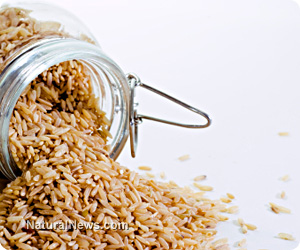Exclusive: Scientific paper that announced high levels of lead in rice suddenly retracted by its author
 Sunday, April 21, 2013 Sunday, April 21, 2013by Mike Adams, the Health Ranger Editor of NaturalNews.com (See all articles...) Tags: imported rice, lead contamination, retraction |

(NaturalNews) A recent scientific paper that concluded imported rice was heavily contaminated with lead has been suddenly withdrawn by its author. Natural News has confirmed from the author, Monmouth University Chemistry Professor Tsanangurayi Tongesayi, that the paper is "recalled until further notice."
The paper, announced with great fanfare at the American Chemical Society last week, was also accepted for publication in the Journal of Environmental Science and Health, Part B: Pesticides, Food Contaminants, and Agricultural Waste. It found that some sources of rice, including rice from China, were contaminated with as much as 12,000% more lead than allowed under current safety limits for children.
The story was widely published across the media, including Natural News. Its findings, after all, were consistent with many other findings about the contamination of foods grown in heavily polluted countries. So no one thought the conclusions might be in doubt. When we hear about "scientists" conducted metals analysis in foods, we tend to think they know what they're doing, right?
But the authors themselves discovered worrisome discrepancies when they sent the samples to a third-party lab for verification. According to an email acquired by Natural News, the results from this third-party lab showed all sub-ppm levels of lead, not the much higher numbers the Tongesayi team had reported.
Why the Tongesayi team did not conduct third-party lab verification before announcing the results has not been explained.
Analysis machine somehow produced flawed data
What has been revealed, however, is that the original lead results were determined through the use of an "XRF" spectroscopy machine which uses X-Ray Fluorescence to profile the elemental composition of the sample.The brand of the XRF machine used in this analysis was "Innov-X," from Olympus, according to information received by Natural News. Click here to see an overview of the products.
Most likely, the Tongesayi team was using the BTX Benchtop XRD equipment, which is about the size of a bread maker and, compared to high-end spectroscopy equipment, also costs about the same as a bread maker. (See below for more analysis of XRF versus atomic spectroscopy / mass analyzers.)
According to their own announcement about their findings:
We measured the levels of lead in rice that is imported into the U.S. using XRF and the data was validated using a NIST1568a reference sample. Lead levels ranged from 5.95 +/- 0.72 to 11.9 +/- 0.6 mg/kg and the calculated Daily Exposure amounts were significantly higher than the Provisional Total Tolerable Intakes for all age groups.
Translation: What they're basically saying is that they found lead at levels of 6 to 12 ppm in rice. But as you'll see below, these numbers are completely wrong.
2012 tests from Consumer Reports reveal roughly 1,000 times LOWER levels of lead in rice
Here's another clue worth considering in all this. In 2012, Consumer Reports published results of its lead analysis of 223 brands of rice. They also measured arsenic and cadmium in rice.If you click the link above, the chart you'll see is shown in parts per BILLION. These numbers, in other words, are 1/1000th the value of numbers given in parts per million. As a reminder, 1000 ppb = 1 ppm.
If someone asks you, "Would you rather each 500 ppm of lead, or 500 ppb of lead?" the correct answer is ppb.
Here's a screen shot of the Consumer Reports report (link above):

The Tongesayi team was announcing that it found rice to contain high ppm of lead. But the Consumer Reports team -- which of course has decades of experience running tightly-controlled lab analysis activities -- was only reporting lead at ppb in rice.
Somebody is off by a factor of 1,000. That's three orders of magnitude. And I'd bet my favorite pair of hiking boots it's not Consumer Reports.
Why I was absolutely shocked to learn these studies were conducted via XRF
Consumer Reports, it turns out, conducted its study of rice using what it called "ICP-DRC-MS." I discuss this is more detail below, but the "DRC" just means it's a jazzed up ICP-MS "mass spec" machine using a Dynamic Reaction Cell. This technology helps eliminate polyatomic interferences (i.e. false readings) through the use of a highly reactive gas (like oxygen) that is allowed to bleed into the analyzer and "react" with problematic ions. The result is a detection limit that approaches low parts per trillion, depending on the element. (Plus, your lab gets the "thrill" of being stocked with explosive gases.)But the Tongesayi team didn't use ICP-MS. They used something called "XRF" -- almost certainly due to budgetary constraints. As someone who has done a considerable amount of hands-on research into trace element analysis of foods, I was absolutely shocked to learn that this "scientific" study about to be published in a science journal was conducted on a single XRF machine without the results being independently confirmed through more accurate testing methods. As much as I feel the professor was trying to do the right thing with this research, if you are going to announce something of such magnitude to the world, for God's sake run a redundancy check on another machine! (Is this not common sense?)
Personally, if I were going to put my name behind test results, I would choose a technology such as ICP-MS: Inductively Coupled Plasma Mass Spectrometry. Also just called "ICP Mass Spec" for short.
A quick overview of ICP-MS mass spectrometry
ICP-MS machines are made by several companies such as Agilent, Perkin Elmer, Bruker and Thermo. They are capable of detecting trace elements down to parts per TRILLION, with astonishing accuracy and repeatability.The really freaking thing is that they can measure all the elements of a given sample simultaneously. So in 2-3 minutes, you get a full read-out of everything in the sample: lead, cadmium, mercury, magnesium, iron... and if you're really lucky then some barium and thallium, too.
Running ICP-MS machines, however, is tricky business. For starters, you need a ridiculously air-tight clean room with active HEPA filtration, or the trace elements in microscopic pieces of dust in the air will throw your results. ICP-MS also typically uses a nebulizer to atomize a liquid solution, and because of the extreme precision of the ICP-MS components, this solution can contain a maximum of 0.2% TDS (dissolved solids). This means solid food samples must be digested, then diluted, and then re-run through the analyzer if the dilution level is still not sufficient to bring the element to within the window of detection by the machine.
ICP-MS is expensive and complicated. And it uses a lot of gas. You'll burn through dozens of gas tanks of argon gas each year. (Well, not actually "burning" them. The gas is harmlessly exhausted after each analysis.) And if you want to run so-called "collision cell" quantitative elemental analysis -- which offers far more precision than standard ICP-MS -- you might end up using other gases such as helium or even nitrogen.
ICP-MS isn't cheap, either. You need to build out a lab room that can keep the machine free of contaminants. Just the room itself might easily cost you $200,000. Most of these machines have a plasma torch that needs 240V electricity hardwired in (because it takes juice to turn solids into their plasma state, right?), and with the auto-diluters, auto-digesters, analysis software and everything else you need to run these systems, you can easily spend $500,000 - $1 million. And that doesn't count the salary and the health insurance benefits of the lab technician you'll need to hire to run the whole thing... the very same guy who will quit right in the middle of your urgent batch run that needs to be done immediately.
But of all the trace element detection technologies available today, I have personally never heard of anyone using XRF as the sole machine for announcing scientific results of heavy metals contamination for food staples.
How one machine might consistently produce false lead contamination results
It's painfully easy for one machine to produce consistently erroneous results due to a number of reasons. Just off the top of my head, I can think of at least four reasons why this might happen:#1) The machine is incorrectly calibrated. These machines must be frequently calibrated against samples with known quantities of detected elements. If they are poorly calibrated, they will obviously produce incorrect results.
#2) Contamination during sample preparation. Whoever was preparing the rice samples was likely using some sort of acidic solution to "digest" the rice into a testable liquid. This process of sample preparation provides a multitude of opportunities for contamination, including the acidic solution, lab ware used in the preparation, ambient lead in airborne dust, the handling of samples by lab technicians, etc.
#3) The machine's sampling area was somehow contaminated with lead. I'm not sure what technology this XRF machine uses to hold the sample being tested, but it is possible that the same machine had previously been used to test something such as an actual piece of lead... and somehow enough lead remained in the testing instrument to give off high ppm with all subsequent samples. This could be determined by testing the unit with a known quantity of ultra-purified laboratory water known to contain no lead whatsoever. If the reading still shows high lead, then the problem is the instrument.
4) Altered data. You can never discount the possibility that someone involved in the research sought to alter the numbers in order to fit their desired outcome. I'm not saying this was the case with this rice research, but it has happened before and must always be considered as a possible explanation.
Conclusion
So that's a long-winded way of saying the "lead contamination in rice" paper has been retracted, and it was pulled because the people who did the study realized their machine was producing erroneous results.So, on one hand, you could say they are doing the "responsible thing" by retracting this paper themselves, but on the other hand this is a pretty big whopper to make in a science journal and a public symposium of the American Chemical Society.
Importantly, the retraction of this paper does not mean rice from China isn't contaminated with lead. There is lead in rice from China, but as Consumer Reports shows, it's most likely in the ppb range than ppm.
Obviously, we're going to continue to investigate this issue and work to bring you more news (and our own lab results) about metals contaminants in food. For now, just remember that not every published "scientific" paper is accurate. There are retractions every single day, and even when people don't intend to make mistakes, they often get caught up in them anyway.
Sources for this article include:
Video announcement of the "lead in rice" research:
http://www.ustream.tv/new/search?q=Tsanangurayi%20Tongesayi
Imported rice at FETCH.news
Get independent news alerts on natural cures, food lab tests, cannabis medicine, science, robotics, drones, privacy and more.
 About the author:Mike Adams (aka the "Health Ranger") is a best selling author (#1 best selling science book on Amazon.com) and a globally recognized scientific researcher in clean foods. He serves as the founding editor of NaturalNews.com and the lab science director of an internationally accredited (ISO 17025) analytical laboratory known as CWC Labs. There, he was awarded a Certificate of Excellence for achieving extremely high accuracy in the analysis of toxic elements in unknown water samples using ICP-MS instrumentation. Adams is also highly proficient in running liquid chromatography, ion chromatography and mass spectrometry time-of-flight analytical instrumentation.
About the author:Mike Adams (aka the "Health Ranger") is a best selling author (#1 best selling science book on Amazon.com) and a globally recognized scientific researcher in clean foods. He serves as the founding editor of NaturalNews.com and the lab science director of an internationally accredited (ISO 17025) analytical laboratory known as CWC Labs. There, he was awarded a Certificate of Excellence for achieving extremely high accuracy in the analysis of toxic elements in unknown water samples using ICP-MS instrumentation. Adams is also highly proficient in running liquid chromatography, ion chromatography and mass spectrometry time-of-flight analytical instrumentation.
Adams is a person of color whose ancestors include Africans and Native American Indians. He's also of Native American heritage, which he credits as inspiring his "Health Ranger" passion for protecting life and nature against the destruction caused by chemicals, heavy metals and other forms of pollution.
Adams is the founder and publisher of the open source science journal Natural Science Journal, the author of numerous peer-reviewed science papers published by the journal, and the author of the world's first book that published ICP-MS heavy metals analysis results for foods, dietary supplements, pet food, spices and fast food. The book is entitled Food Forensics and is published by BenBella Books.
In his laboratory research, Adams has made numerous food safety breakthroughs such as revealing rice protein products imported from Asia to be contaminated with toxic heavy metals like lead, cadmium and tungsten. Adams was the first food science researcher to document high levels of tungsten in superfoods. He also discovered over 11 ppm lead in imported mangosteen powder, and led an industry-wide voluntary agreement to limit heavy metals in rice protein products.
In addition to his lab work, Adams is also the (non-paid) executive director of the non-profit Consumer Wellness Center (CWC), an organization that redirects 100% of its donations receipts to grant programs that teach children and women how to grow their own food or vastly improve their nutrition. Through the non-profit CWC, Adams also launched Nutrition Rescue, a program that donates essential vitamins to people in need. Click here to see some of the CWC success stories.
With a background in science and software technology, Adams is the original founder of the email newsletter technology company known as Arial Software. Using his technical experience combined with his love for natural health, Adams developed and deployed the content management system currently driving NaturalNews.com. He also engineered the high-level statistical algorithms that power SCIENCE.naturalnews.com, a massive research resource featuring over 10 million scientific studies.
Adams is well known for his incredibly popular consumer activism video blowing the lid on fake blueberries used throughout the food supply. He has also exposed "strange fibers" found in Chicken McNuggets, fake academic credentials of so-called health "gurus," dangerous "detox" products imported as battery acid and sold for oral consumption, fake acai berry scams, the California raw milk raids, the vaccine research fraud revealed by industry whistleblowers and many other topics.
Adams has also helped defend the rights of home gardeners and protect the medical freedom rights of parents. Adams is widely recognized to have made a remarkable global impact on issues like GMOs, vaccines, nutrition therapies, human consciousness.
In addition to his activism, Adams is an accomplished musician who has released over a dozen popular songs covering a variety of activism topics.
Click here to read a more detailed bio on Mike Adams, the Health Ranger, at HealthRanger.com.
Take Action: Support Natural News by linking to this article from your website
Permalink to this article:
Embed article link: (copy HTML code below):
Reprinting this article:
Non-commercial use OK, cite NaturalNews.com with clickable link.
Follow Natural News on Facebook, Twitter, Google Plus, and Pinterest
- Newly released JFK files reveal Pentagon's role in creating Lyme disease and covid in the same lab
- The hidden dangers in your kitchen: How cooking methods impact diabetes, cancer and aging
- DEADLY DECEPTION: How COVID vaccines increased mortality rates and why authorities hid the truth
- CDC finally halts $11 billion COVID funding scam as health officials admit the ‘pandemic’ was a fraud
- Arkansas embraces medical freedom with landmark ivermectin law
- GAIN-OF-FUNCTION CAT-BIRD-FLU now on the rise as nearly a dozen cats in Colorado "test positive" for Bird Flu due to contaminated cat food
- Lab leak confirmed? Boris Johnson's stunning reversal on COVID origins sparks global debate
- Home gardening for preppers: A beginner's guide to growing your own food
- Trump's greatest betrayal so far: Accelerating Middle East wars, silencing dissent, and serving Zionist masters
- Why you should think twice before buying mainstream toothpaste formulas
- Cartels shift tactics: Kidnappings and organ trafficking surge as border crossings plummet under Trump policies
- Was JFK's assassination orchestrated by a CIA double agent? New evidence points to James Angleton as the “architect”
- ATTENTION PRESIDENT TRUMP: Please WITHDRAW your nomination of Dr. Susan Monarez for CDC Director as she is a VAX FANATIC and TOXIC JAB ZEALOT
- Key nodes of Federal Government censorship
- Here are TEN all-natural ways to protect your garden without using harmful chemicals
- Record honeybee deaths devastate U.S. agriculture, pesticides under scrutiny
- Speaker Johnson warns Congress may defund or disband rogue courts targeting Trump
- Paper or plastic? The environmental deception behind bag bans
- Newly released JFK files reveal Pentagon's role in creating Lyme disease and covid in the same lab
- Elon Musk: Aliens could be here on Earth RIGHT NOW
- Festive flavors: The sweet history, nutritional profile and health benefits of pecan pie
- Trump reverses course on Gaza plan, says “nobody is expelling Palestinians”
- Reclaim your health: How midlife exercise reverses years of inactivity
- Big Pharma's $8 Billion bribery scheme exposed: how doctors are pushed to prescribe junk science, not heal
- Boys are back in town: Trump’s patriotic alpha crew takes the wheel while toxic females ride in the backseat
- EPA advisor admits the agency is funneling billions to climate groups ahead of Trump’s return to White House
- Space war brewing? Russia threatens to destroy Starlink satellites
- Survival 101: Effective EMF blocking techniques
- A lack of integrity in Academia: Harvard professor found GUILTY of fraudulent research to promote CRT theory
- Mike Adams Sermon 66: God will DESTROY ISRAEL for its wickedness
- 5 Simple steps to boost your brainpower: How to strengthen executive function in a distracted world
- Rep. Nancy Mace introduces bill to ban biological males from female facilities on federal property
- Sugarcane extract superior to cholesterol-lowering drugs?
- WHO focusing more on policing speech about public health and implementing global surveillance systems
- Pilots report mysterious lights 'moving at extreme speeds' across Oregon skies
- Dr. Mike Yeadon releases 15-minute testimony - WATCH - about genocidal intent of COVID “vaccines”
- EPA advisor admits the agency is funneling billions to climate groups ahead of Trump’s return to White House
- The Health Ranger releases “Vaccine Zombie” song and music video, using AI-animated zombies for the music video
- California's social media censorship law struck down: A victory for free speech or a threat to online safety?
- Dr. Mike Yeadon releases 15-minute testimony - WATCH - about genocidal intent of COVID “vaccines”
- The pandemic as a tool for INDOCTRINATION: Understanding “The Indoctrinated Brain” by Dr. Michael Nehls
- Florida takes a stand: DeSantis proposes permanent ban on mRNA vaccine mandates
- Mike Adams releases country western hit single: Goin’ Back in Time is Comin’ Home
- Mike Adams releases music poetry sensation: A Child of God
- “Why we influenced the 2020 elections”: Facebook files reveal the coordinated effort to bury the Hunter Biden laptop story
- RFK Jr. clears key hurdle: Sen. Susan Collins backs controversial HHS nominee, signaling a new era for health policy
- Unpacking the Lies That We’ve Been Fed – new song and music video released by Mike Adams, the Health Ranger
- Mike Adams releases new song and music video: Nothing More Disgusting Than a Globalist
- Newly released JFK files reveal Pentagon's role in creating Lyme disease and covid in the same lab
- Congratulations to the FULLY UNVACCINATED as you resisted the COVID-19 PROPAGANDA MACHINE fueled by over $100 BILLION
- Michigan sheriff announces criminal investigation into 2020 election crimes, Dominion Voting Systems
- Israeli soldiers accused of even more torture and abuse in the West Bank
- Migrants are taking advantage of recent hurricanes to scam residents and loot their homes
- House Intelligence Committee calls for the ARREST and PROSECUTION of Dr. Anthony Fauci
- Red Cross issues warning to stop blood plasma donations from vaccinated people
- Scientists confirm: GENIUS brain function can be spontaneously unleashed in humans without any apparent cause
- EPA advisor admits the agency is funneling billions to climate groups ahead of Trump’s return to White House
- HYSSOP: What research reveals about the health benefits of this ancient holy herb
- Two containers with completed ballots fall out of truck in Florida
- Fully vaccinated about to see “tsunami” of illness and death, warns virologist
- Global leaders unite to clamp down on “misinformation” with UN-backed Cascais Declaration
- BREAKING: 2025 NDAA authorizes mandatory military draft of WOMEN across America… as Pentagon pursues global NUCLEAR war with both Russia and China at the same time
- Michael Yon warns of a ZIONIST TAKEOVER in Trump’s second administration
- BOMBSHELL: DNA testing kits are a SCAM to develop ethnic-specific bioweapons
- Ozempic and Wegovy weight loss drugs are injectable LIZARD VENOM PEPTIDES that may unleash a devastating wave of organ failure… side effects align with symptoms of SNAKE BITES
- Israeli soldiers accused of even more torture and abuse in the West Bank
- These 13 countries just signed an agreement to engineer a global FAMINE by destroying food supply
- NASA admits that climate change occurs because of changes in Earth’s solar orbit, and NOT because of SUVs and fossil fuels
- RFK Jr. clears key hurdle: Sen. Susan Collins backs controversial HHS nominee, signaling a new era for health policy
- Sermon 30: How Jesus reveals Caesar’s FAKE CURRENCY and FALSE AUTHORITY
- Coriander seeds: Ancient medicine backed by modern science
- Arizona officials claim Maricopa County needs 10-13 days to tabulate results of the election
Science News & Studies
Medicine News and Information
Food News & Studies
Health News & Studies
Herbs News & Information
Pollution News & Studies
Cancer News & Studies
Climate News & Studies
Survival News & Information
Gear News & Information
News covering technology, stocks, hackers, and more



"Big Tech and mainstream media are constantly trying to silence the independent voices that dare to bring you the truth about toxic food ingredients, dangerous medications and the failed, fraudulent science of the profit-driven medical establishment.
Email is one of the best ways to make sure you stay informed, without the censorship of the tech giants (Google, Apple, Facebook, Twitter, YouTube, etc.). Stay informed and you'll even likely learn information that may help save your own life."
–The Health Ranger, Mike Adams












































